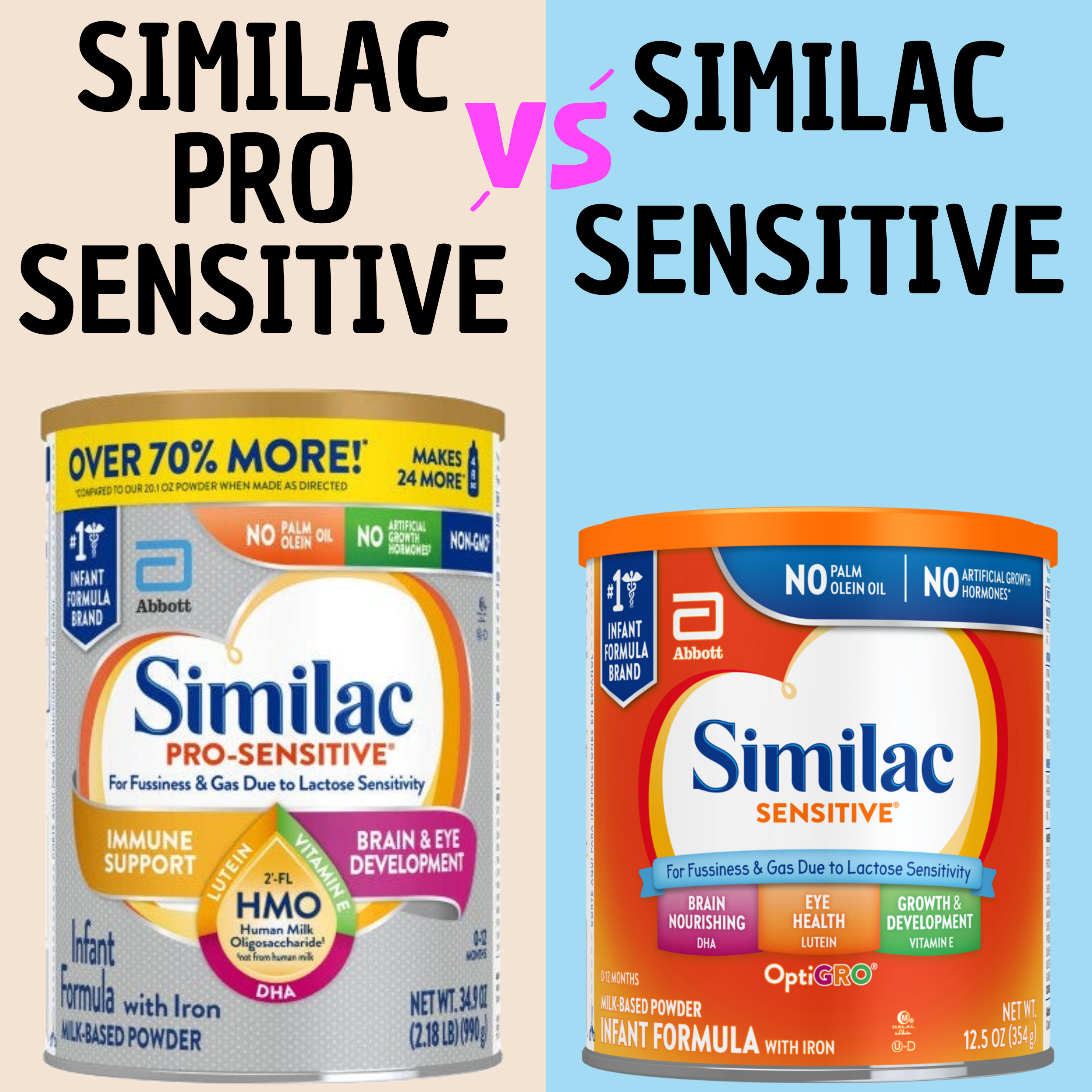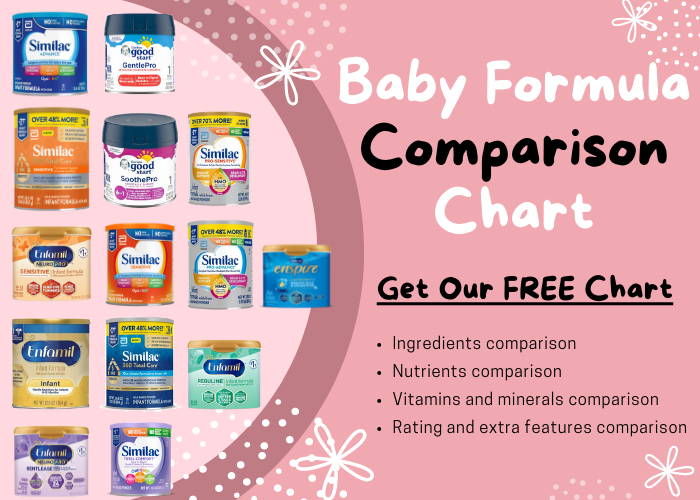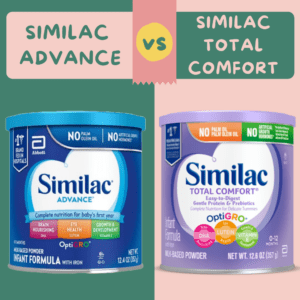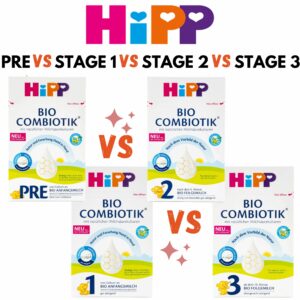What’s The Difference Between Similac Sensitive and Pro Sensitive?
Similac Sensitive and Pro Sensitive are formulated for infants with lactose sensitivity, featuring a 99% lactose reduction and milk protein isolate for gentle digestion and reduced risk of discomfort. But, What’s The difference?
The difference lies in their prebiotics and GMO status. Similac Pro Sensitive is non-GMO and contains two prebiotics, 2′-FL HMO and Short-chain Fructooligosaccharides, promoting gut health. Similac Sensitive has just one prebiotic, Short-chain Fructooligosaccharides. These differences cater to parents seeking a more natural and gut-friendly formula option.
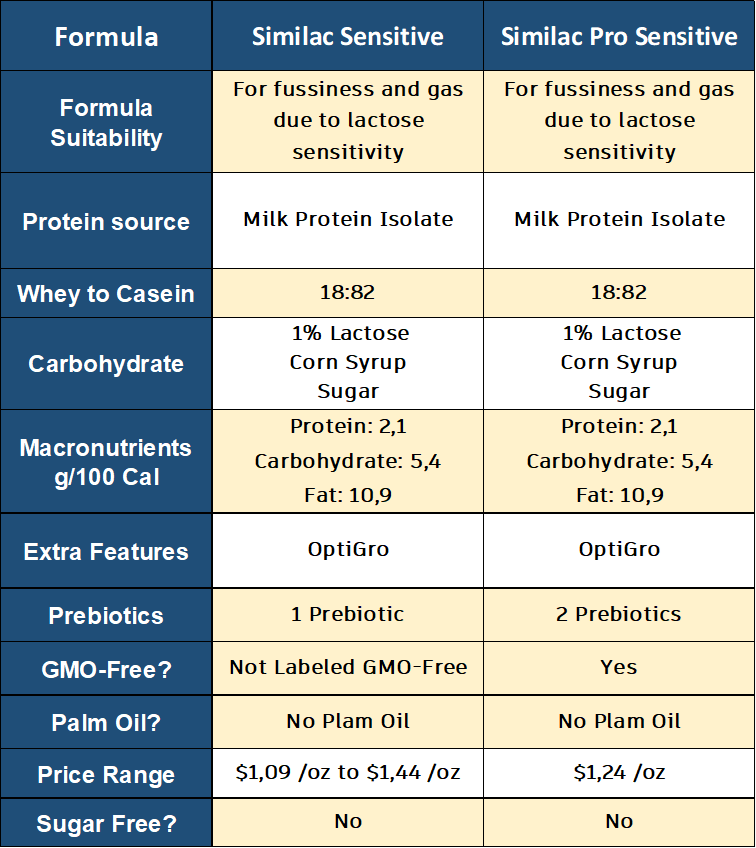
Parents’ Reviews Comparison:
Similac Sensitive and Similac Pro Sensitive are both well-established formula options for parents seeking to address their infants’ specific dietary needs. However, these formulas have distinct characteristics and, as a result, they tend to elicit varying opinions from parents who have used them:
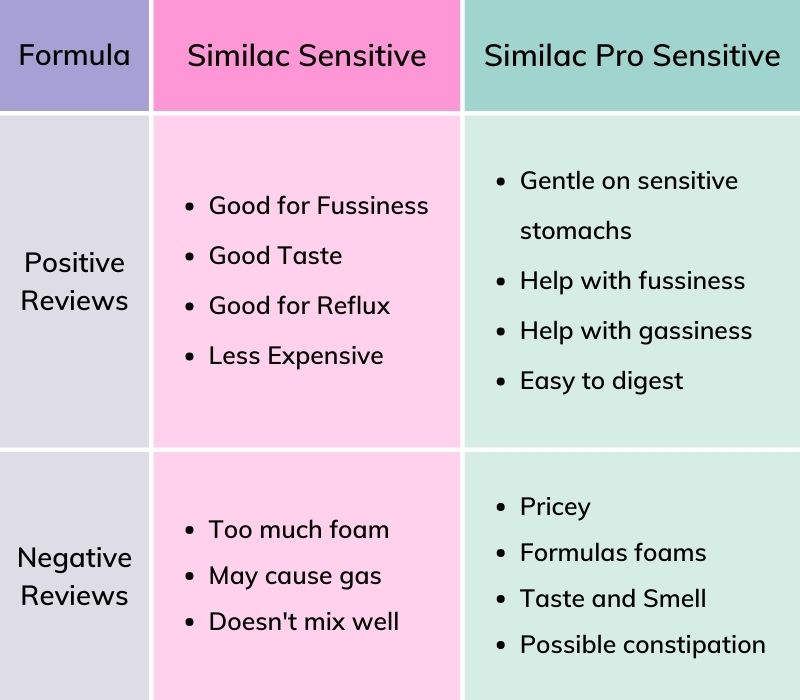
Similac Sensitive:
Positive Reviews:
- Good for Fussiness: Similac Sensitive often receives praise for its effectiveness in reducing fussiness in infants. Many parents have reported that their babies appear calmer and more content after switching to this formula.
- Good Taste: Babies’ acceptance of the formula is another positive aspect frequently highlighted in reviews. The taste of Similac Sensitive seems to be agreeable to many little ones, making the transition from breast milk or another formula easier.
- Good for Reflux: For infants struggling with reflux issues, this formula is often seen as a helpful choice. It can alleviate the symptoms associated with acid reflux, offering relief to both babies and their parents.
- Less Expensive: In comparison to some other specialty formulas, Similac Sensitive is often considered a more budget-friendly option. This can be a significant advantage for parents looking for a cost-effective solution.
Related: Similac Sensitive Vs. 360 Total Care Sensitive
Negative Reviews:
- Too much foam: One common criticism of this formula is that it tends to produce excessive foam when preparing the formula. This can be an inconvenience and lead to messiness during feeding.
- May cause gas: Some parents have reported that their infants experienced increased gas or bloating when using Similac Sensitive. It’s essential to monitor your baby’s reaction to the formula to determine if it’s a suitable choice for them.
- Doesn’t mix well: The formula’s mixing properties have been called into question by some parents, who find that it doesn’t dissolve as smoothly as they would prefer. This can create texture issues in the bottle.
Similac Pro Sensitive:
Positive Reviews:
- Gentle on sensitive stomachs: Similac Pro Sensitive is designed for infants with sensitive digestive systems. Parents often praise its ability to soothe stomach discomfort and reduce instances of digestive upset.
- Help with fussiness: Similar to Similac Sensitive, this formula is appreciated for its capacity to alleviate fussiness, making for happier and more content babies.
- Help with gassiness: The formula’s effectiveness in reducing gassiness is another frequently cited positive aspect. Many parents find that it leads to less discomfort and crying due to gas.
- Easy to digest: Similac Pro Sensitive’s ingredients are formulated for easier digestion, and this is often highlighted in reviews. Babies who struggle with digestive issues may find relief with this formula.
Negative Reviews:
- Pricey: A drawback often associated with Similac Pro Sensitive is its higher price point compared to other formulas. This can be a concern for budget-conscious parents.
- Formula foams: Just like Similac Sensitive, this formula is known to produce foam when mixed. While it might not be a deal-breaker for some, it’s worth noting for parents who prefer less foamy formulas.
- Taste and Smell: Some parents have reported that Similac Pro Sensitive has a distinctive taste and smell that may not be to every baby’s liking.
- Possible constipation: While it’s designed for sensitive stomachs, some babies might experience constipation as a side effect of using this formula. It’s essential to monitor your baby’s response carefully.
Ingredients Comparison:
Similac Sensitive and Similac Pro Sensitive are both designed for infants aged 0-12 months, sharing several core ingredients while also featuring distinct elements that cater to specific infant needs. Here’s a detailed comparison of their ingredients:

Protein Source:
Both formulas rely on Milk Protein Isolate as their primary protein source. This source is favored in infant formulas as it contains essential amino acids necessary for healthy growth and development.
Additionally, both formulas maintain a whey-to-casein ratio of 18:82, which closely mirrors the composition of breast milk. This balanced ratio ensures optimal digestibility and nutrient absorption, making it suitable for infants with sensitive stomachs.
Carbohydrate Source:
In the case of carbohydrate sources, both Similac Sensitive and Similac Pro Sensitive utilize a combination of corn syrup and sugar. However, they share a unique characteristic – a 99% reduction in lactose content. This reduction in lactose is especially important for infants with lactose sensitivity, making both formulas well-suited for this group.
Related: Similac Sensitive Vs. Similac Total Comfort
Fat Source:
Both formulas incorporate a blend of high oleic safflower oil, soy oil, and coconut oil as their fat sources. These fats provide essential fatty acids and support healthy brain and eye development in infants. Furthermore, both Similac Sensitive and Similac Pro Sensitive are fortified with DHA and ARA, which are critical for neural and visual development.
Palm Oil:
Notably, both formulas are palm oil-free. This is a feature often appreciated by parents who have concerns about palm oil’s sustainability and its potential impact on an infant’s digestion. The absence of palm oil underscores the commitment of these formulas to delivering high-quality nutrition without compromising on these vital aspects.
Prebiotics:
Prebiotics play a significant role in supporting a healthy gut in infants. Similac Sensitive contains Short-chain Fructooligosaccharides as the prebiotic component. These prebiotics promote gut health and encourage the growth of beneficial bacteria in the infant’s digestive system.
Similac Pro Sensitive, however, takes it a step further by featuring “2′-FL HMO (2′-Fucosyllactose)” in addition to Short-chain Fructooligosaccharides as prebiotics. The inclusion of 2′-FL HMO is a notable feature, as it structurally resembles the prebiotic found in breast milk.
This may offer additional benefits for gut health, which could be of particular interest to parents seeking a formula that more closely mirrors the composition of breast milk.
GMO-Free:
While Similac Sensitive is not explicitly labeled as GMO-Free, Similac Pro Sensitive proudly holds this label. For parents who are concerned about genetically modified ingredients, this distinction can be a significant factor in their choice.
Generic Brands:
For those seeking budget-friendly options without compromising on nutrition, both Similac Sensitive and Similac Pro Sensitive have generic or store-brand alternatives available. These generic options offer a cost-effective solution for parents while still providing essential nutrients for their infants.
Related: Best 7 Generic Brands For Similac Sensitive & Pro Sensitive
Source of ARA and DHA:
The source of ARA (arachidonic acid) for both formulas is Mortierella alpina oil, and the source of DHA (docosahexaenoic acid) is Crypthecodinium cohnii oil. These sources have been chosen due to their safety and efficacy in delivering these crucial nutrients to support infant brain and eye development.
Nutrients Comparison:
Similac Sensitive and Similac Pro Sensitive share similar macronutrient and vitamin profiles, making them suitable choices for infant nutrition. Here’s a detailed comparison of the macronutrients and vitamins in both formulas, based on their content per 100 calories (5 fluid ounces):

Macronutrients:
Protein, g: Both Similac Sensitive and Similac Pro Sensitive provide 2.1 grams of protein per 100 calories. This protein content is essential for an infant’s growth, tissue development, and overall health.
Fat, g: Both formulas contain 5.4 grams of fat per 100 calories. Fat is crucial for an infant’s brain development and the absorption of fat-soluble vitamins.
Carbohydrate, g: Both Similac Sensitive and Similac Pro Sensitive offer 10.9 grams of carbohydrates per 100 calories. Carbohydrates, including the reduced lactose content, provide a vital energy source for infants and support their overall growth and development.
Vitamins:
- Both formulas provide a comprehensive range of essential vitamins, ensuring that infants receive a balanced nutrient profile.
- Vitamin A, IU: 300 IU per 100 calories
- Vitamin D, IU: 60 IU per 100 calories
- Vitamin E, IU: 1.5 IU per 100 calories
- Vitamin K, mcg: 8 mcg per 100 calories
- Vitamin B1, mcg: 100 mcg per 100 calories
- Vitamin B2, mcg: 150 mcg per 100 calories
- Vitamin B6, mcg: 60 mcg per 100 calories
- Vitamin B12, mcg: 0.25 mcg per 100 calories
- Niacin, mcg: 1050 mcg per 100 calories
- Folic Acid, mcg: 15 mcg per 100 calories
- Pantothenic Acid, mcg: 450 mcg per 100 calories
- Biotin, mcg: 4.4 mcg per 100 calories
- Vitamin C, mg: 9 mg per 100 calories
- Choline, mg: 24 mg per 100 calories
- Inositol, mg: 24 mg per 100 calories
Both Similac Sensitive and Similac Pro Sensitive aim to provide infants with a well-rounded mix of macronutrients and essential vitamins, supporting their growth and development during the crucial first months of life. The nutrient content per 100 calories is carefully balanced to meet the specific nutritional requirements of infants and ensure they receive all the vital elements for their overall health.
Related: Similac Advance Vs. Similac Sensitive
Minerals:
Similac Sensitive and Similac Pro Sensitive provide infants with essential minerals necessary for their growth and development. Here’s a detailed comparison of the mineral content in both formulas, based on their content per 100 calories:
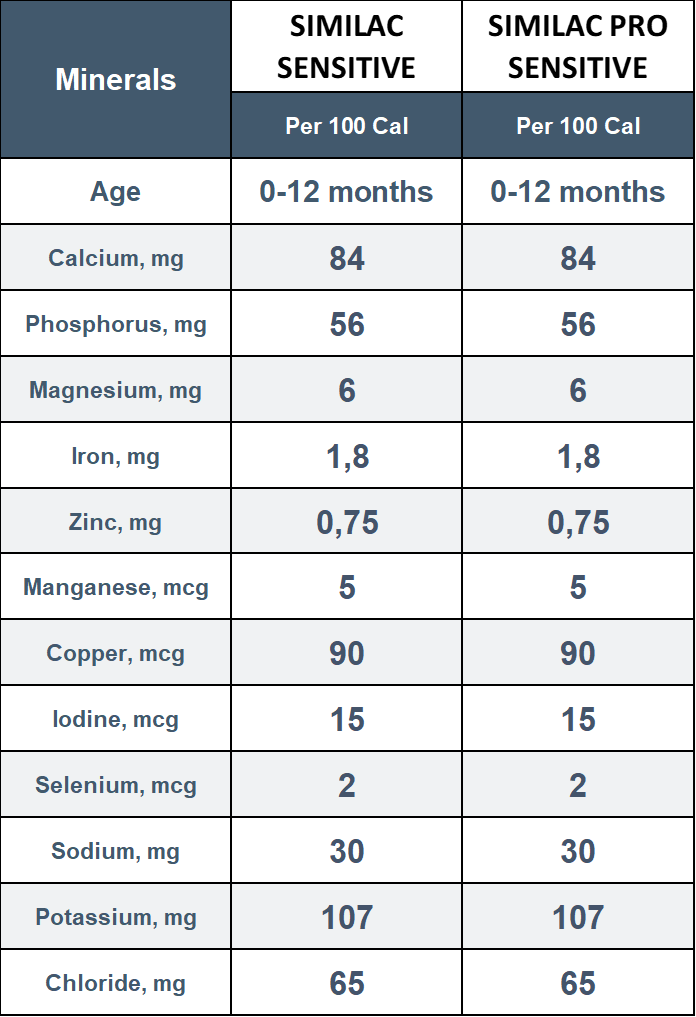
Both formulas share identical mineral content per 100 calories, ensuring that infants receive a consistent and balanced supply of essential minerals. These critical minerals, such as calcium, phosphorus, iron, zinc, and others, play a pivotal role in supporting an infant’s growth, development, and overall well-being, making both formulas a reliable choice for meeting these specific nutritional requirements.
Price Comparison:
| Similac Pro Sensitive | Similac Sensitive |
|---|---|
| – | 12.5 oz 17.94 $ 1.44/oz Buy 12.5 oz |
| 22.5 oz 25.94 $ 1.15/oz Buy 22.5 oz | |
| 29.8 oz 32.54 $ 1.09/oz Buy 29.8 oz | |
| 29.8 oz 36.96 $ 1.24 /oz Buy 29.8 oz | 34.9 oz 37.92 $ 1.09 /oz Buy 34.9 oz |
| 32 fl oz 8.12$ 25.4 ¢/fl oz Buy RTF | 32 fl oz 7.82 $ 24.4 ¢/fl oz Buy RTF |
| 4.2 of 5.0 1027 reviews Walmart | 4.6 of 5.0 2275 reviews Walmart |
When considering the price comparison between Similac Sensitive and Similac Pro Sensitive, it’s essential to take into account the various factors, including container size, unit price, and parent reviews, as these can significantly influence your choice.
Similac Sensitive offers versatility in terms of container sizes, catering to different needs and budgets. The 34.9 oz container is the most cost-effective option, priced at $1.09 per ounce. This larger size is favored by parents who prefer to buy in bulk, as it provides more formula for the money.
Similac Sensitive has garnered a high rating of 4.6 out of 5.0 from a substantial 2275 reviews, indicating a high level of parent satisfaction and confidence in the product’s quality. Additionally, it offers a ready-to-feed option, adding convenience for parents on the go.
Similac Pro Sensitive is available in a 29.8 oz container, priced at $1.24 per ounce. While it may be more expensive per ounce compared to Similac Sensitive, it provides a reasonable cost per serving. Furthermore, Similac Pro Sensitive offers a 32 fl oz ready-to-feed option at 25.4 cents per fluid ounce.
However, it has a lower parent rating of 4.2 out of 5.0 from 1027 reviews on Walmart. It’s important to note that the parent rating, while slightly lower, still signifies a generally positive reception from users because some ratings are related to shipping and other things related to the seller.
Can You Mix Similac Sensitive and Pro Sensitive?
Yes, you can mix Similac Sensitive and Similac Pro Sensitive without any issues. These formulas have similar main ingredients (protein and carbohydrate sources) and serve the same general purpose of providing nutrition for infants with sensitive stomachs due to lactose sensitivity.
Can You Switch Between Similac Sensitive and Pro Sensitive?
Yes, you can switch between Similac Sensitive and Similac Pro Sensitive without significant issues. They are both designed for infants with sensitive stomachs and share similar main ingredients. However, closely monitor your baby’s response to ensure the switch agrees with their digestive needs. Always follow the recommended guidelines provided on the formula packaging for a smooth transition.
How to Switch Between Similac Sensitive and Pro Sensitive?
Switching between Similac Sensitive and Similac Pro Sensitive can be done gradually to ensure a smooth transition for your baby. Here’s a step-by-step guide on how to make the switch:
- Consult with Your Pediatrician: Before making any changes to your baby’s formula, it’s a good idea to discuss it with your pediatrician to ensure it aligns with your baby’s specific needs.
- Start Slowly: Begin by mixing the two formulas. In the first bottle, use a higher proportion of the current formula your baby is accustomed to (e.g., Similac Sensitive), and a smaller portion of the new formula (Similac Pro Sensitive). For example, you can start with 75% Similac Sensitive and 25% Similac Pro Sensitive.
- Monitor Your Baby: Over a few days or up to a week, gradually increase the proportion of the new formula while decreasing the old formula. Observe how your baby responds during this transition period. Look for any signs of digestive discomfort or allergies.
- Adjust Based on Your Baby’s Response: If your baby tolerates the new formula well and doesn’t show any adverse reactions, you can continue to increase the proportion of Similac Pro Sensitive until it becomes the sole formula.
- Be Patient: Keep in mind that every baby is different, and it may take some time for your baby’s digestive system to adjust to the new formula. Patience and a gradual approach are key.
- Maintain Consistency: Once you’ve made the complete switch to Similac Pro Sensitive, maintain consistency by using this formula exclusively. This helps your baby’s digestive system adapt to the new formula.
- Stay Hydrated: Throughout the transition, make sure your baby remains well-hydrated by offering small, frequent feedings.
Remember, it’s essential to be attentive to your baby’s cues and monitor their response during the transition. If you notice any significant issues or if your baby experiences discomfort, consult with your healthcare provider for guidance and to rule out any allergies or sensitivities.
The Best One?
The choice between Similac Sensitive and Similac Pro Sensitive ultimately depends on your specific priorities and your baby’s needs:
Similac Sensitive is the more budget-friendly option and is well-regarded for addressing fussiness, reflux, and lactose sensitivity. It’s a good choice for parents seeking a cost-effective solution that caters to their baby’s sensitive stomach.
Similac Pro Sensitive, on the other hand, is non-GMO and features two prebiotics, potentially offering additional benefits for gut health. It is preferred for its ease of digestion, effectiveness in reducing fussiness and gassiness, and is also suitable for babies with lactose sensitivity.
The “best” choice depends on your priorities. If you value non-GMO ingredients and advanced prebiotics, Similac Pro Sensitive might be your preferred option. If you’re more budget-conscious and primarily focused on addressing fussiness, reflux, and lactose sensitivity, Similac Sensitive could be the better choice. Ultimately, both are reputable formulas; it’s a matter of aligning with your specific concerns and your baby’s requirements.
Resources:
https://www.abbottnutrition.com/our-products/similac-sensitive-20
Credit to:

